Camping Food List and Meal Planning Tips
This post may contain affiliate links.
Take the stress out of prepping for your next camping trip with this camping food list! When you have these essential ingredients with you, it will be easy to make simple but tasty camping meals from scratch!
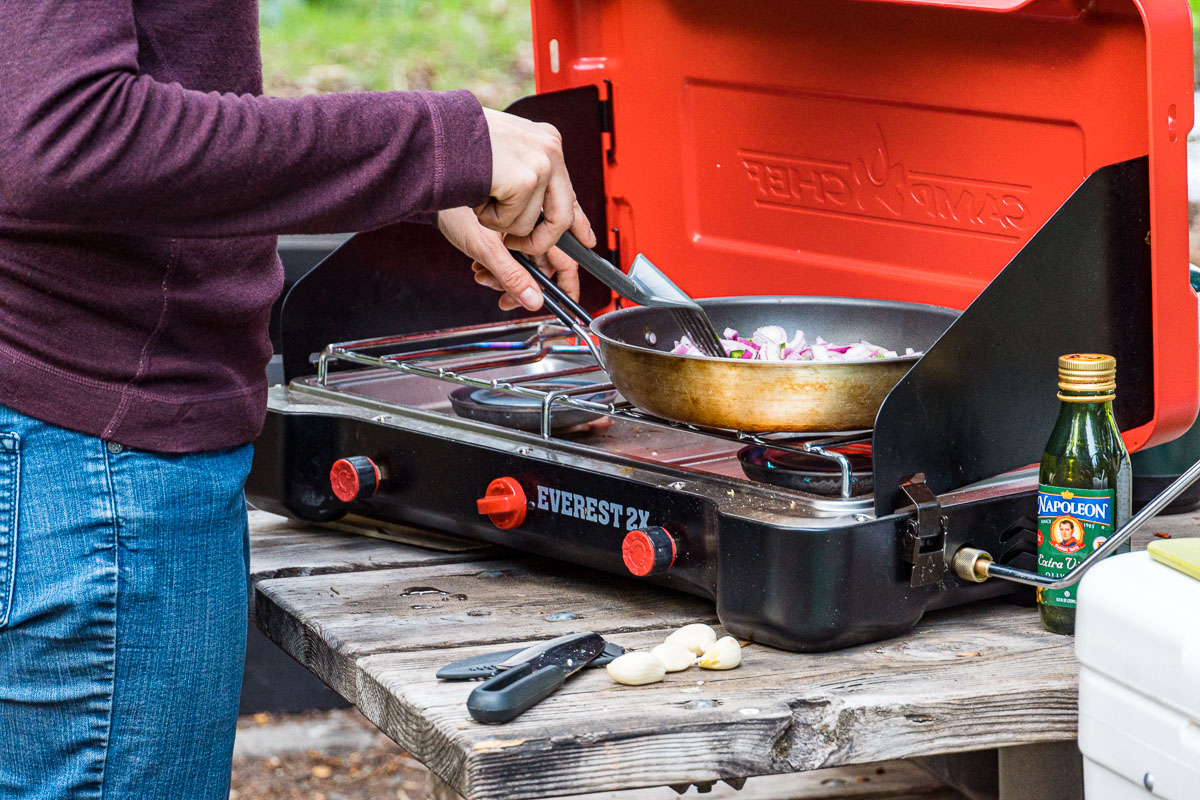
You’ve booked your campsite, planned your activities, and packed everything on your camping checklist… next, you need to pack all the food you’ll need. This is often the most time-consuming part of prepping for a camping trip.
One of the best ways to have a low-stress camp cooking experience is to make a detailed meal plan. Planning out exactly what you’ll eat for each breakfast, lunch, and dinner means you’ll always know what’s coming up and only bring the ingredients you need. While this approach is great for short weekend trips, it’s not for everybody.
Maybe you’re not usually a recipe-following type of meal planner. Or, maybe you’re preparing for a longer trip and don’t want to get bogged down with excessive planning.
In that case, it might be better to use a camping food list instead. This is just a list of ingredients that are well-suited for camping and can be mixed and matched to make any variety of meals. It is more of a free-form approach to camp cooking.
Below, we’re sharing a list of our go-to camping foods. If you’re rushing out the door on an impromptu camping trip and don’t have time to meal plan, these ingredients are great to have on hand to take the stress out of mealtime!
Our Essential Camping Food List
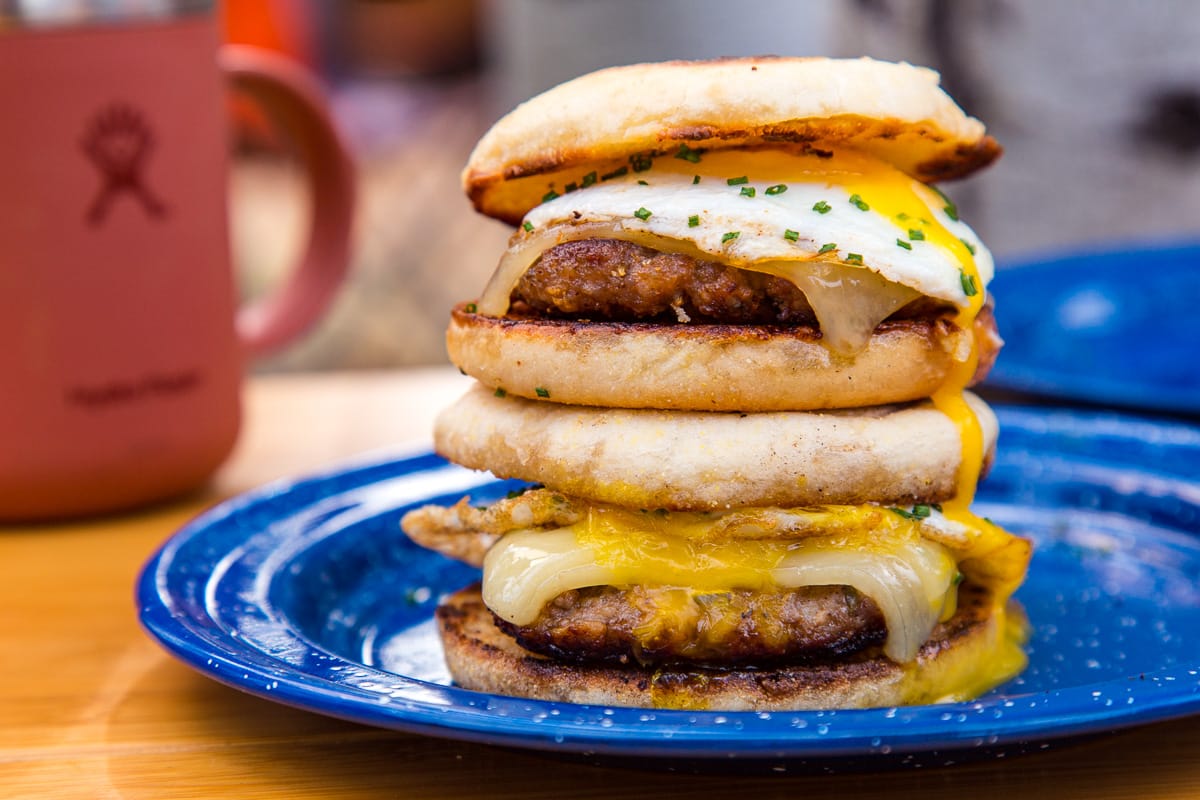
English Muffins
We love bringing along a package of English muffins on our camping trips. They don’t require any room in our cooler and they are a great starting point for a number of simple meals. Toast these in a skillet on the stove or campfire!
- Use them for: Serve with peanut butter, jam, or butter for an easy breakfast or as a side for something more substantial like a Mountain Skillet. Or, pair them with sausage and a fried egg for a tasty breakfast sandwich! Beyond breakfast, try English muffins topped with peanut butter and fresh fruit for a snack, or make sandwiches using toasted muffins and cold cuts.
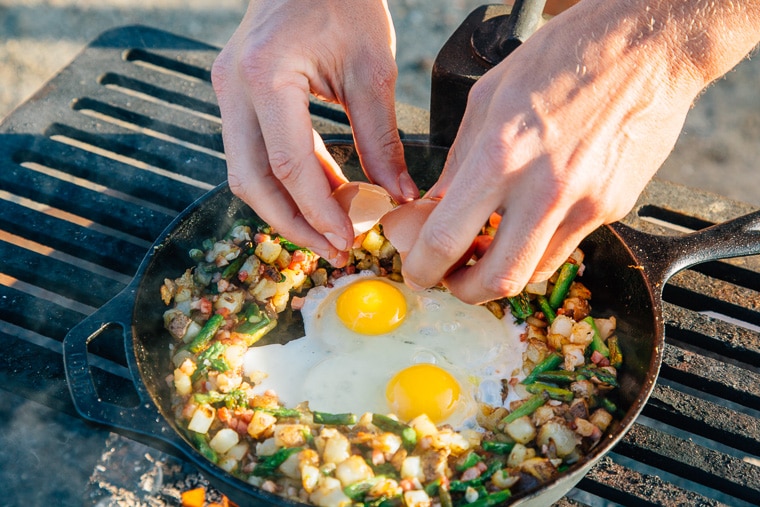
Eggs
Eggs are a camp breakfast staple, and are a great source of protein to help you start an active day on the right foot.
- How to use them: Use fresh eggs in scrambles, omelets, fried with breakfast hash, make a Dutch Baby, build a breakfast sandwich, add them to shakshuka, or use them to make pancakes or French toast. Hard boiled eggs make a great snack that can be prepared at home ahead of your trip, or chop them up to make an egg salad sandwich.
- Storage tips: Pick up one of these protective containers and transfer the eggs to it before storing in your cooler. Or, crack and beat them at home and store them in a mason jar or other watertight container (in your cooler) if you’re going to use them exclusively for scrambles (use within two days after cracking them).
Camp Hack: Don’t want to deal with fresh eggs? We use OvaEasy powdered eggs when we’re backpacking, but they are a great ingredient to have in a camping pantry, too. Honestly, the taste and texture are pretty spot on.
Peanut Butter
Peanut butter (or other nut butter) is one of those things that always gets packed for our trips! It’s virtually non-perishable and can be used in a dozen different ways at the campsite, from snacks, to meals, to sauces.
- Use it for: Spread on toast, in sandwiches for lunch (with jam or fresh fruit!), stirred into oatmeal for breakfast. It’s also great for savory dishes and can be stirred into ramen, used to make a dipping sauce for kabobs, and it’s featured in this Sweet Potato & Peanut Stew.
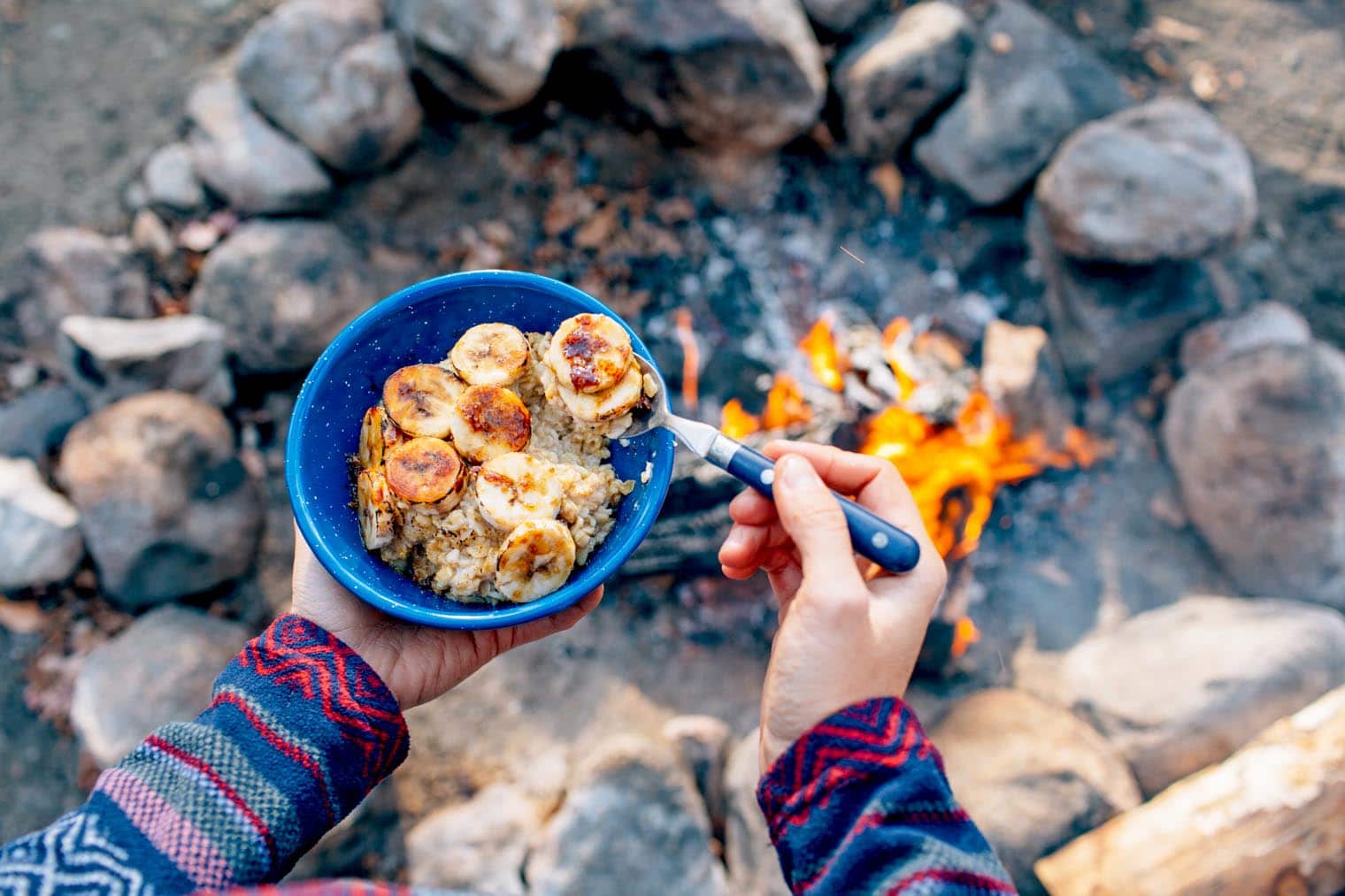
Oats
Oats–whether rolled or instant–are great to have in your camping pantry for a quick and easy breakfast or fruit desserts like our Campfire Baked Apples.
- Zhuzh it up: Try adding a drizzle of maple syrup, fresh fruit, and chopped nuts to your oatmeal. Or, stir in some jam and peanut butter for PB&J Oats.
- Overnight oats: We love overnight oats, and they are so easy to make in your cooler for a no-cook breakfast in the morning. Try adding fresh berries or make peach overnight oats!
Granola
Granola is another staple to have on hand for a no-fuss breakfast, just serve it with milk or yogurt, and maybe some fresh fruit. Granola is also our secret hack to the easiest campfire apple crisp dessert!
- Easy Apple Crisp: Slice apples or cut in to small chunks and add them to a skillet with some butter, brown sugar, and spices like cinnamon. Saute until the apples are soft, then top with granola. Dessert is served!
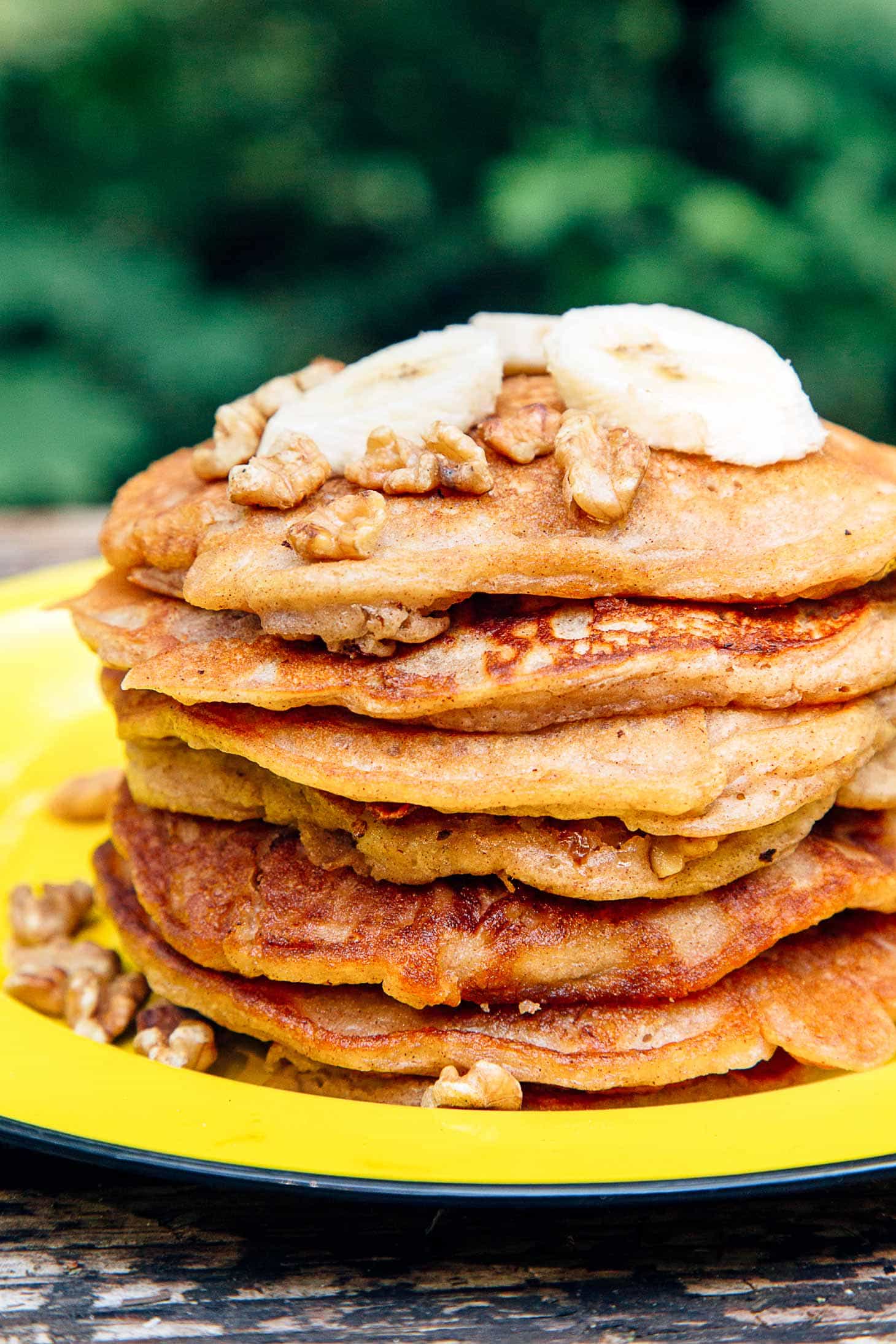
Pancakes
From scratch or from a box, pancakes are a classic camping breakfast!
- Dress them up: Aside from classic toppings like maple syrup and real butter, there are lots of ways to make pancakes feel extra special. Try adding bananas and blueberries, or make Chocolate Chip Pancakes for your kids (or kids-at-heart). In the fall, topping pancakes with cinnamon apples or stirring some pumpkin butter into the batter will help capture those cozy autumn camping vibes.
Bagels & Cream Cheese
Bagels with cream cheese are one of the quickest and easiest camp breakfast options. If you want, you can toast the bagels in a skillet with a bit of butter, or directly over the campfire for a smoky twist (keep an eye on them so they don’t burn!)
- Other serving ideas: Use bagels to make bacon and egg sandwiches, or keep things vegetarian/vegan with hummus and thinly sliced veggies instead.
- Storage tips: Bagels can be kept in a bag in your camp pantry. Cream cheese needs to stay in your cooler. It’s likely that once it’s opened, the container won’t be completely watertight, so keep it in the top basket or sealed in a bag or transfer it to a water-tight container.
Baked Goods
Another great grab-and-go breakfast is pre-made baked goods! Think buttermilk blueberry muffins, croissants, coffee cake, cinnamon rolls, and zucchini or banana bread. Cookies are nice to have on for afternoon coffee and tea time, and rolls make an easy side dish for a lot of camping dinners.
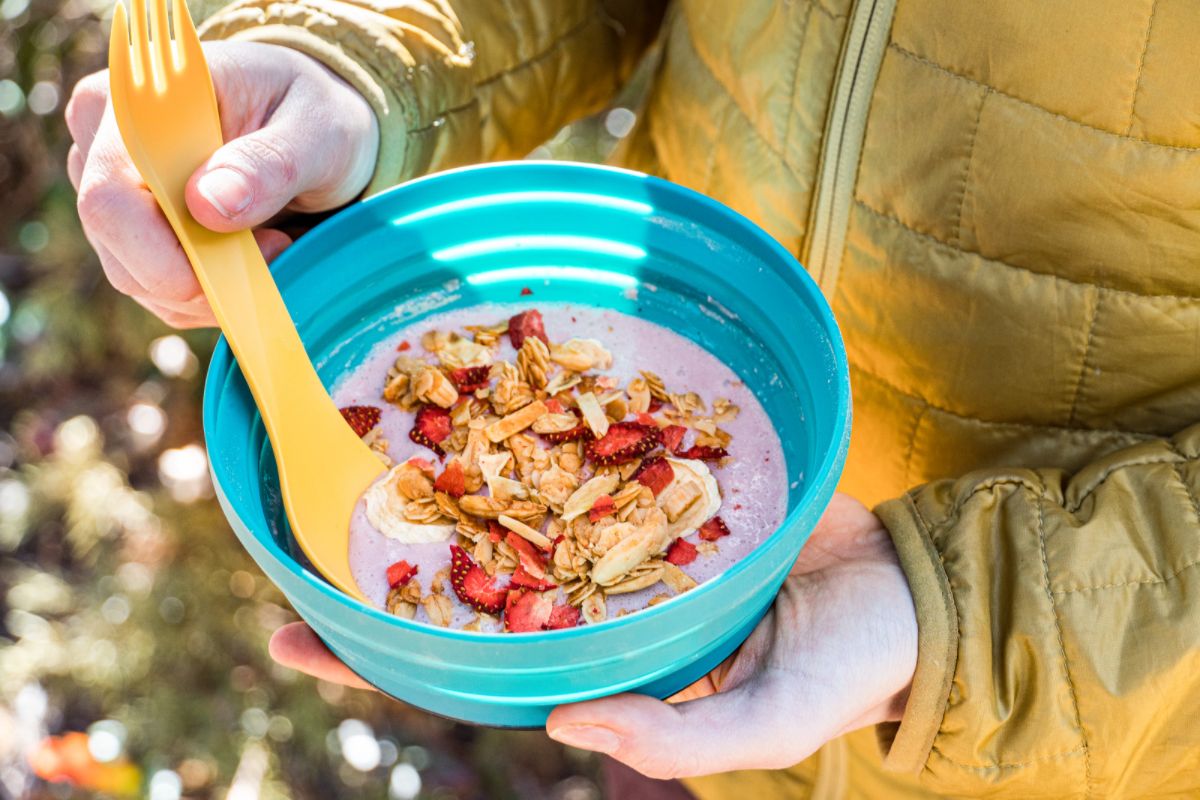
Yogurt
One of the simplest breakfasts for camping is a bowl of yogurt topped with fruit, honey, and maybe some granola or chopped nuts. No cooking, no fuss! Yogurt makes for a great condiment to serve with meals like these Greek Chicken Skewers and Grilled Gyro Kebabs. We also like to serve it with fruit for a healthy dessert, like in this Grilled Peaches with Yogurt recipe.
- Storage tips: Single serve yogurt cups are easy enough to store in your cooler, though it’s best to keep them towards the top so the foil lid doesn’t puncture. The larger tubs tend not to have truly water tight lids, so you will want to ensure that they are stored upright, with the lid above any waterline that has developed.
Milk
Milk, whether dairy or an alternative, has a lot of uses in the camp kitchen. You’ll need it in pancakes, French toast, and scrambled eggs or frittata–or for simple breakfasts like cereal. And, at the end of the evening, nothing beats a cup of hot cocoa made with real milk! It’s a level of delicious that hot water alone just can’t provide.
- Storage tips: Milk cartons or jugs that have a screw on lid are much easier to store in a cooler than the cardboard folding-spout cartons as they don’t have to remain upright.
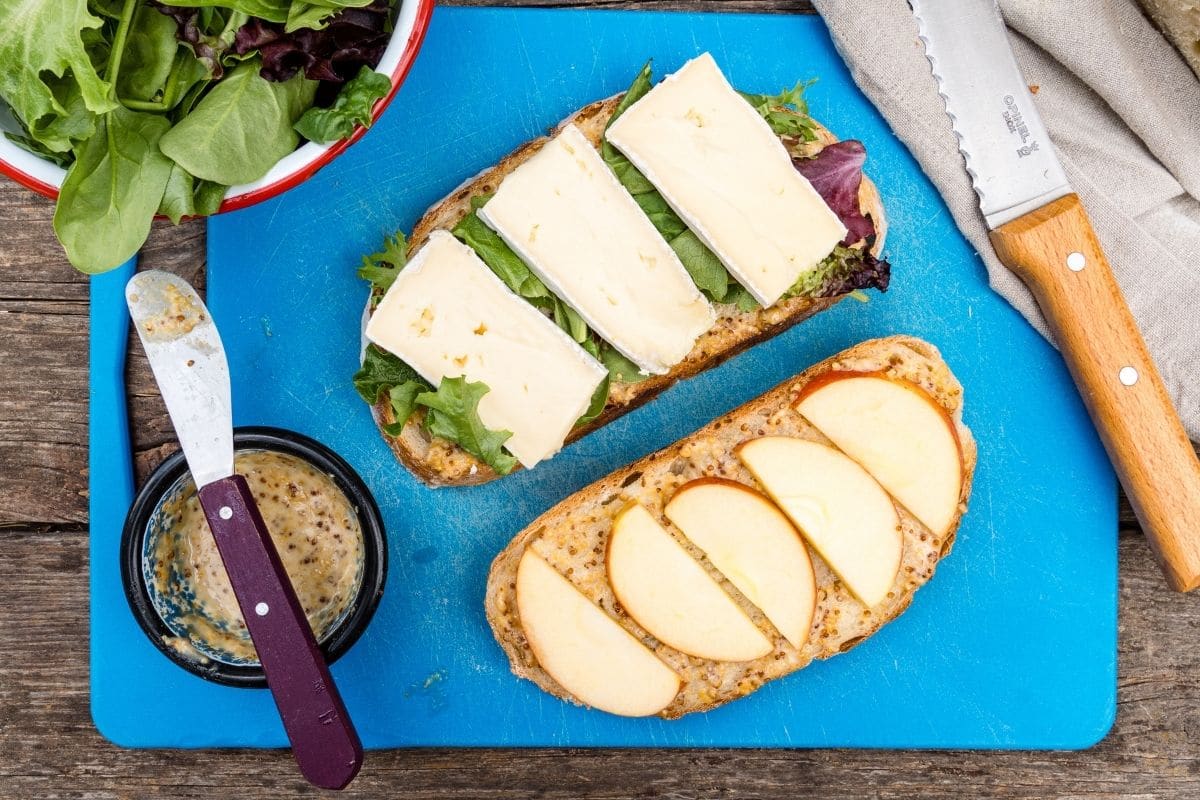
Cheese
Cheese is a must-have food item for snacking and meals! Pack baybel wheels or string cheese for a simple snack for kids or for day excursions. Shredded cheese can be used in all kinds of meals–pre-shredded cheese makes life easier, though for dishes like mac & cheese, grating your own (you can do this ahead at home) will give you a smoother consistency once melted.
- How to use it: Shredded cheese is great to have to hand for meals like Dutch Oven Mac & Cheese, camping nachos, BBQ Chicken Quesadillas, and Dutch Oven Chili. Sliced cheese is perfect to bring for sandwiches and hamburgers.
- Storage tips: Cheese will need to be kept in the cooler, and we recommend storing it in a water-tight baggie (like these) or storage container, just in case.
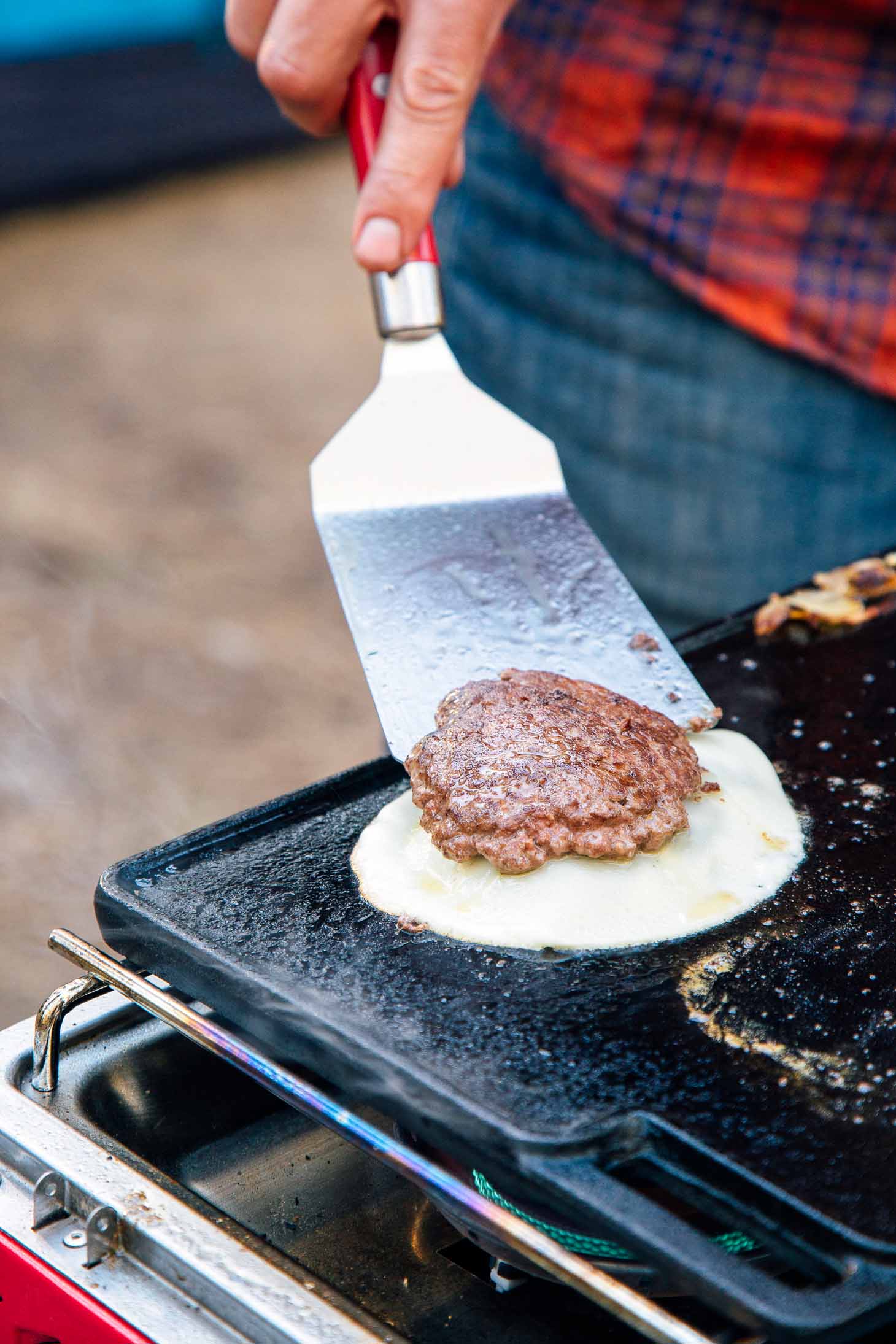
Meats & proteins
The star of most meals, meat or alternative proteins have an important place on your camping food list. Here are a few to consider along with our favorite recipes for how to use them!
- Chicken breast or chicken thighs: Thighs are ideal for campfire cooking because they are very forgiving. Try them in these Grilled Chicken Tacos or Pineapple Chicken Kabobs.
- Steaks: Another great grilling option–all you really need is a good cut and maybe a herby sauce like chimichurri to top it off. Or, get fancy and try your hand at Beef Stroganoff!
- Ground beef: Essential for burgers, chili mac, tacos, and more.
- Bacon or breakfast sausage: Need we say more?! Serve with a side of fried eggs and toast, or make Breakfast Sandwiches or a Mountain Breakfast Skillet.
- Bratwurst, kielbasa, or sausages: Great for grilling, adding to a foil packet meal (like these Kielbasa and Potato foil packets), or in sausage and peppers hash
- Frozen shrimp: Frozen shrimp stores easily and thaw quickly, making them an easy addition to meals like Shrimp Boil Foil Packets, shrimp tacos, and simple grilled shrimp with herb butter.
- Tofu: For plant-based campers, this is a versatile protein source that can be used to make everything from a Tofu Scramble, Thai Curries, or cubed and added to kabobs and skewers (it soaks up all the flavors of your marinade!)
Storage tips: Meat should be transferred to a water-tight container before adding it to your cooler–you really don’t want their juices leaking out into your melting ice water. If your camping trip is a few days, try freezing the meat you’ll use towards the end of the trip–it will help keep your cooler colder! Let it get a head start thawing in the cooler by moving it to the top of the ice the day before you’ll use it. Non-frozen meat should be kept at the bottom of the cooler, where it’s coldest.
Sandwich meat / cold cuts
Sandwiches are such an easy lunch to make camping, so add your favorite deli slices or cold cuts to your list!
- Storage tips: Be sure to pack along a zip-top bag to transfer the meat to once you open the packaging. We’ve found that even if the package claims to be resealable, it’s often not a tight enough seal to prevent water from leaking in.
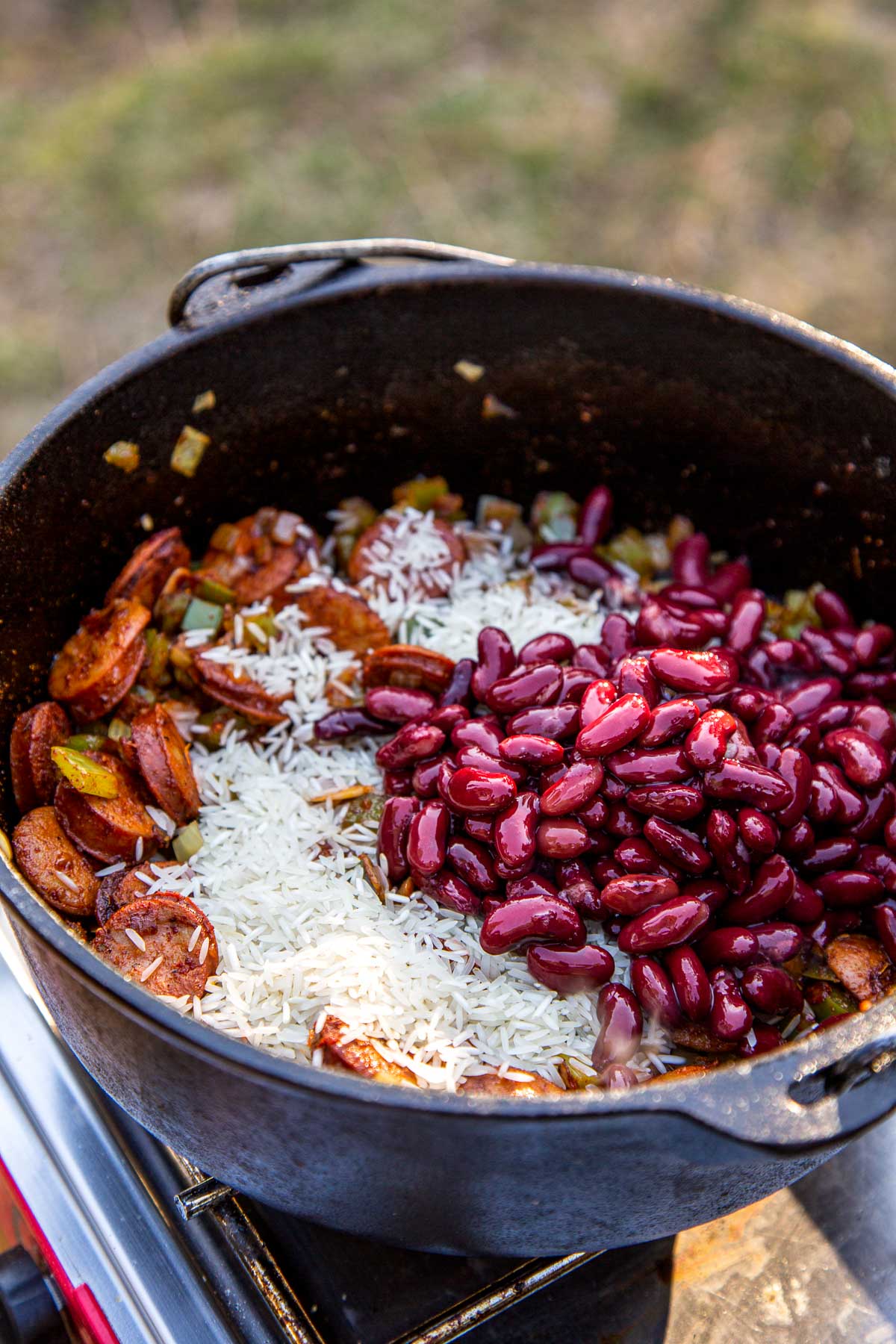
Canned Beans
Canned beans are another one of our favorite camping ingredients. They can be used in so many meals as a vegetarian/vegan protein, and are shelf stable so you can always keep a few on hand in case of mealtime emergencies. Just don’t forget the can opener!
- Use them in: Chili mac, added to pasta for protein, grilled nachos, in tacos, red beans and rice, and curry. We’ve even used canned chickpeas in place of potatoes to make breakfast hash!
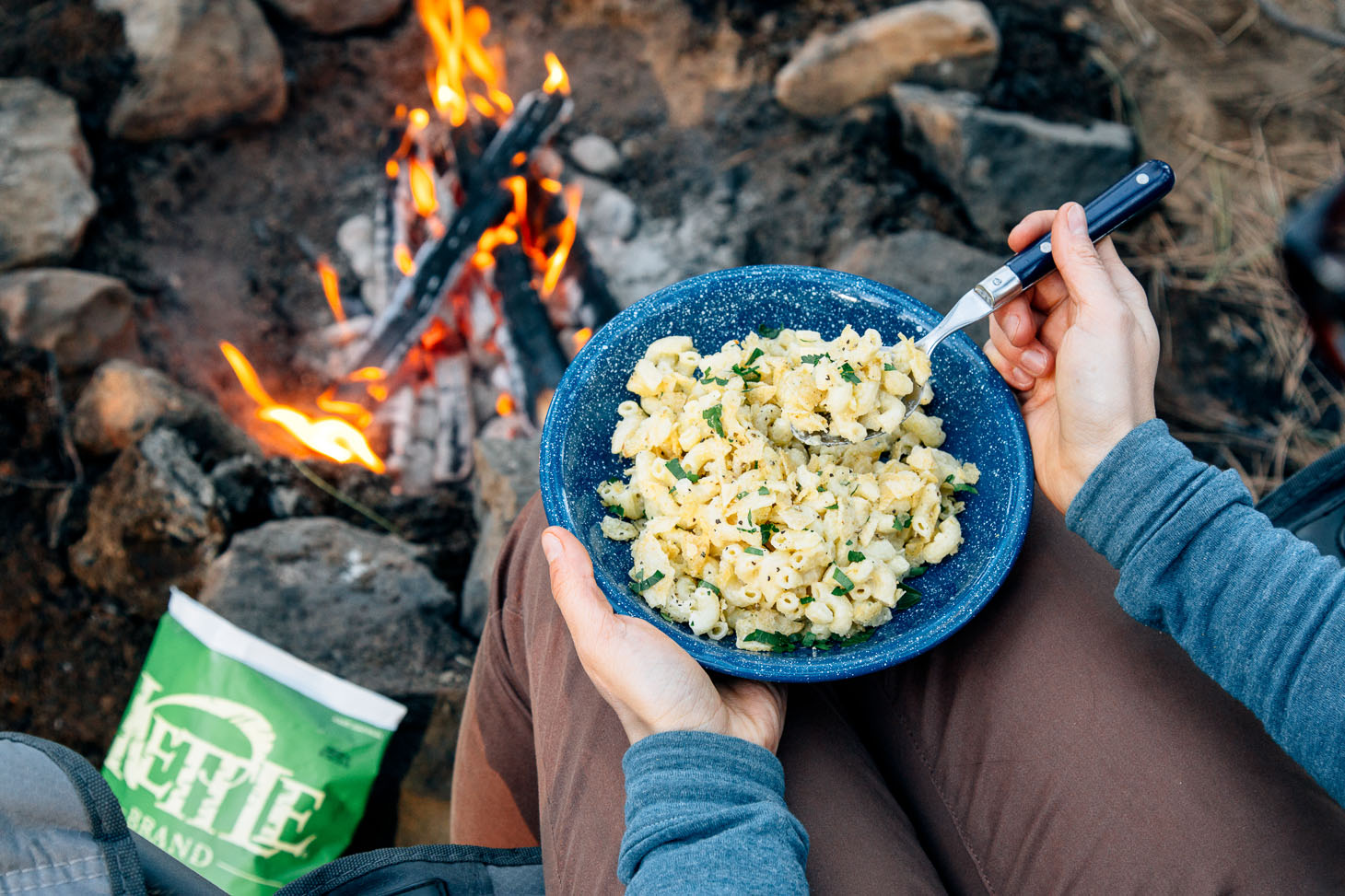
Mac & Cheese
You just can’t beat the convenience that boxed mac & cheese brings to the table. Having these in your camp pantry means you always have a quick lunch on hand for little hungry campers, and there are lots of ways to make it into a full meal. Try chopping up last night’s leftover sausages or hamburger patties, or saute a handful of diced vegetables to increase the nutrition.
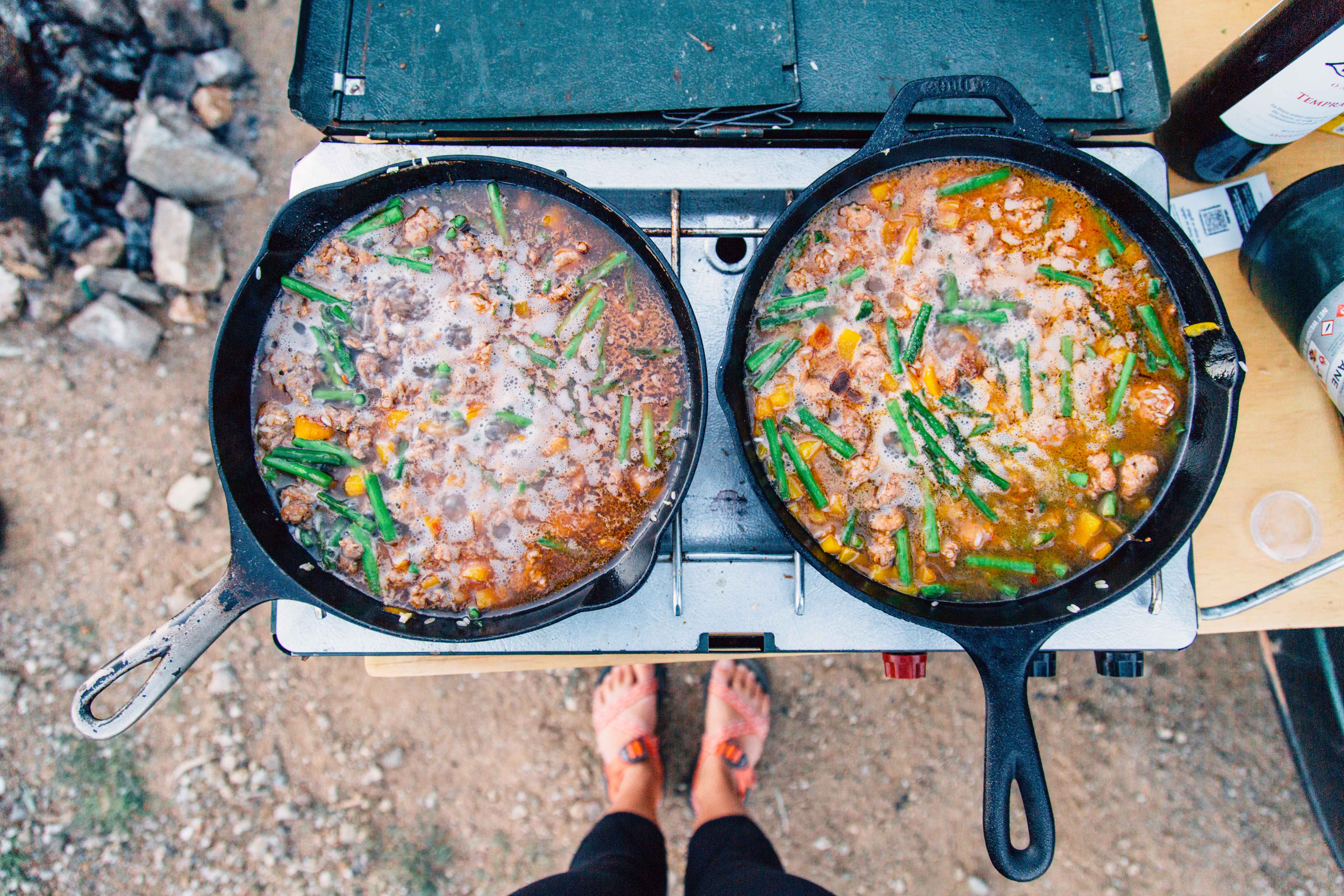
Rice Sides
Boxed, pre-made rice sides are another convenience food option we like to add to our camping food checklist. They make for a super-duper easy side dish with grilled meat and vegetables (think rice pilaf), or you can use them as a base for a meal (like Zatarain’s Jambalaya mix–try adding grilled shrimp or sausages!).
Soup/Dried Soup Mixes
Soup is one of the simplest camping lunch and dinner options, so it’s a good idea to have a can or two of your favorites in your camp pantry. This is always on the top of our camping grocery list for trips where we know we’re going to be out adventuring during the day and won’t have a ton of time or energy to prepare a meal from scratch back at the campsite later. Ramen soup noodles are also nice to have on hand to add to a stir fry (just cook them without the seasoning packet) or curry.
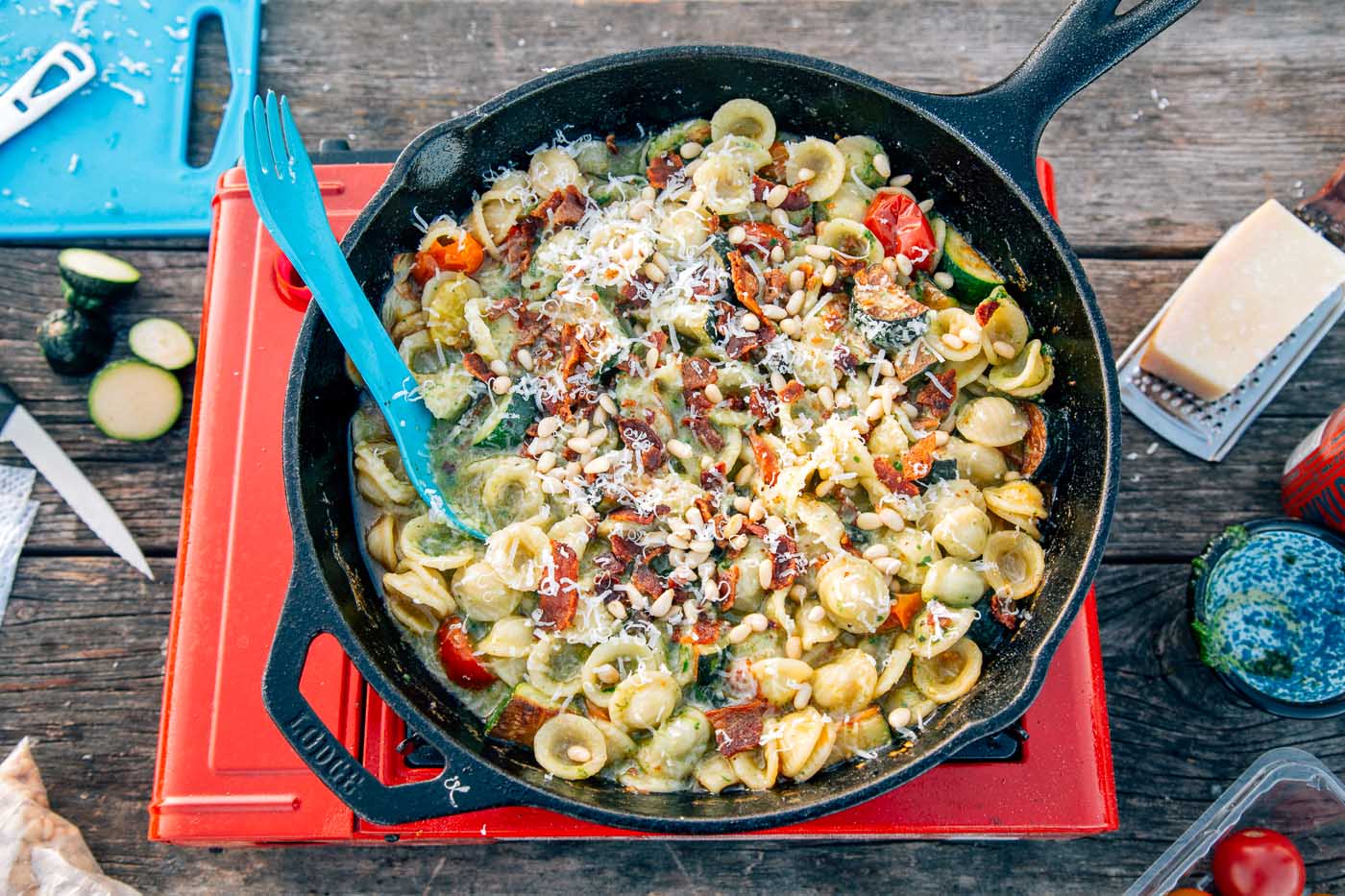
Pasta
Pasta is one of the best camping pantry items! It is the base of SO many easy meals, so we always carry a box so we have extra food on hand in case we need to stretch a meal to be bigger or we end up hanging out at camp for an extra day. In addition to dry pasta, fresh or frozen tortellini or ravioli kept in a cooler can be a great start to a tasty, low-hassle meal–just add your favorite sauce and sauteed or grilled vegetables!
- Use it in: Quick one pot pasta dishes, chili mac or from-scratch mac and cheese, Tortellini Soup, or side dishes like pasta salad.
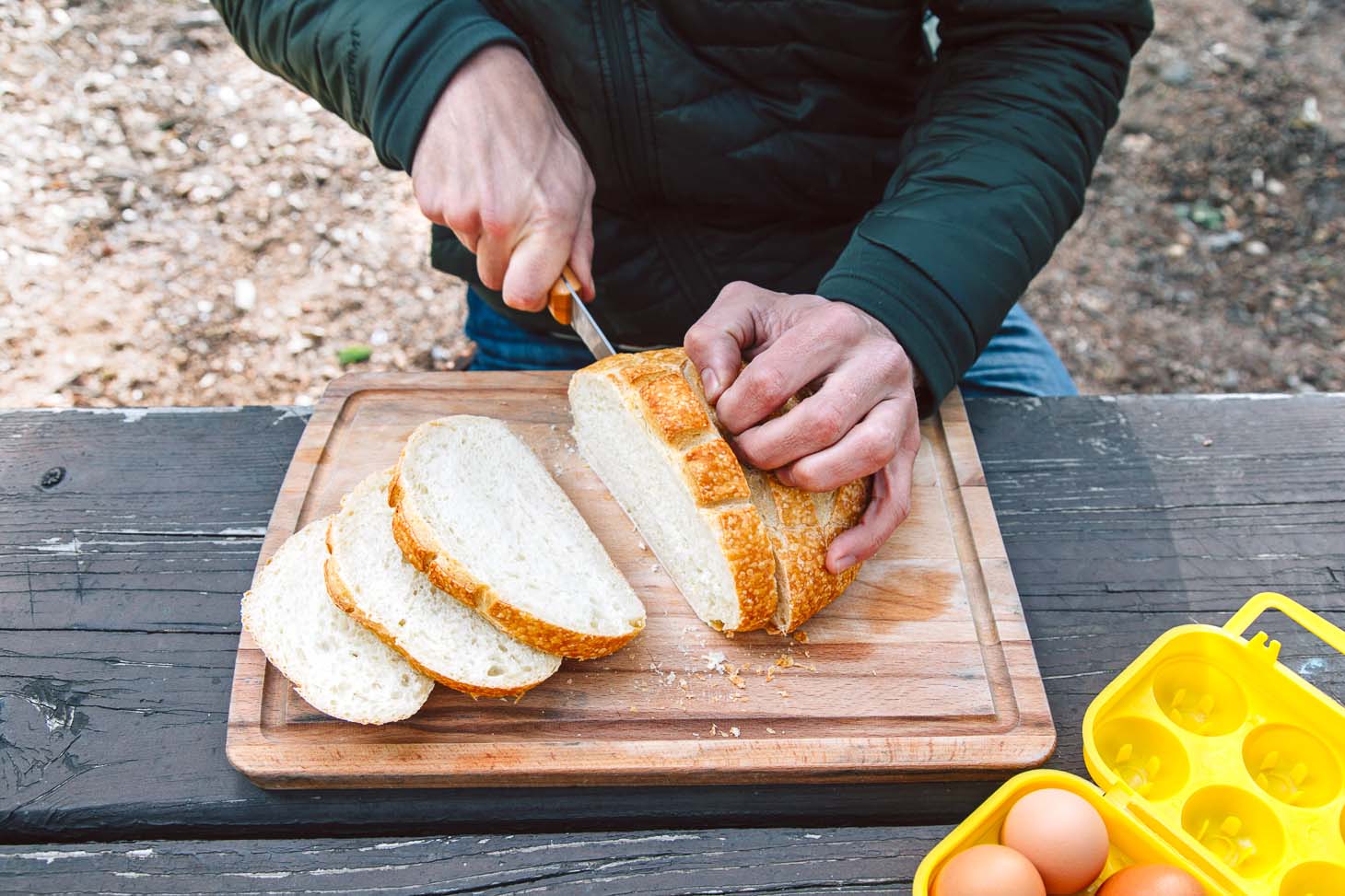
Bread
Bread is essential for making toast, sandwiches, and French toast! Breads like baguettes or country loaves are also excellent for slicing and grilling to serve on the side of meals like soups, grilled meat, skillet ratatouille, or these shrimp boil foil packets.
Tortillas & Wraps
Tortillas and wraps are a less bulky alternative to bread that can be used to make roll-up sandwiches, quesadillas, tacos, Dutch oven enchiladas, and more!
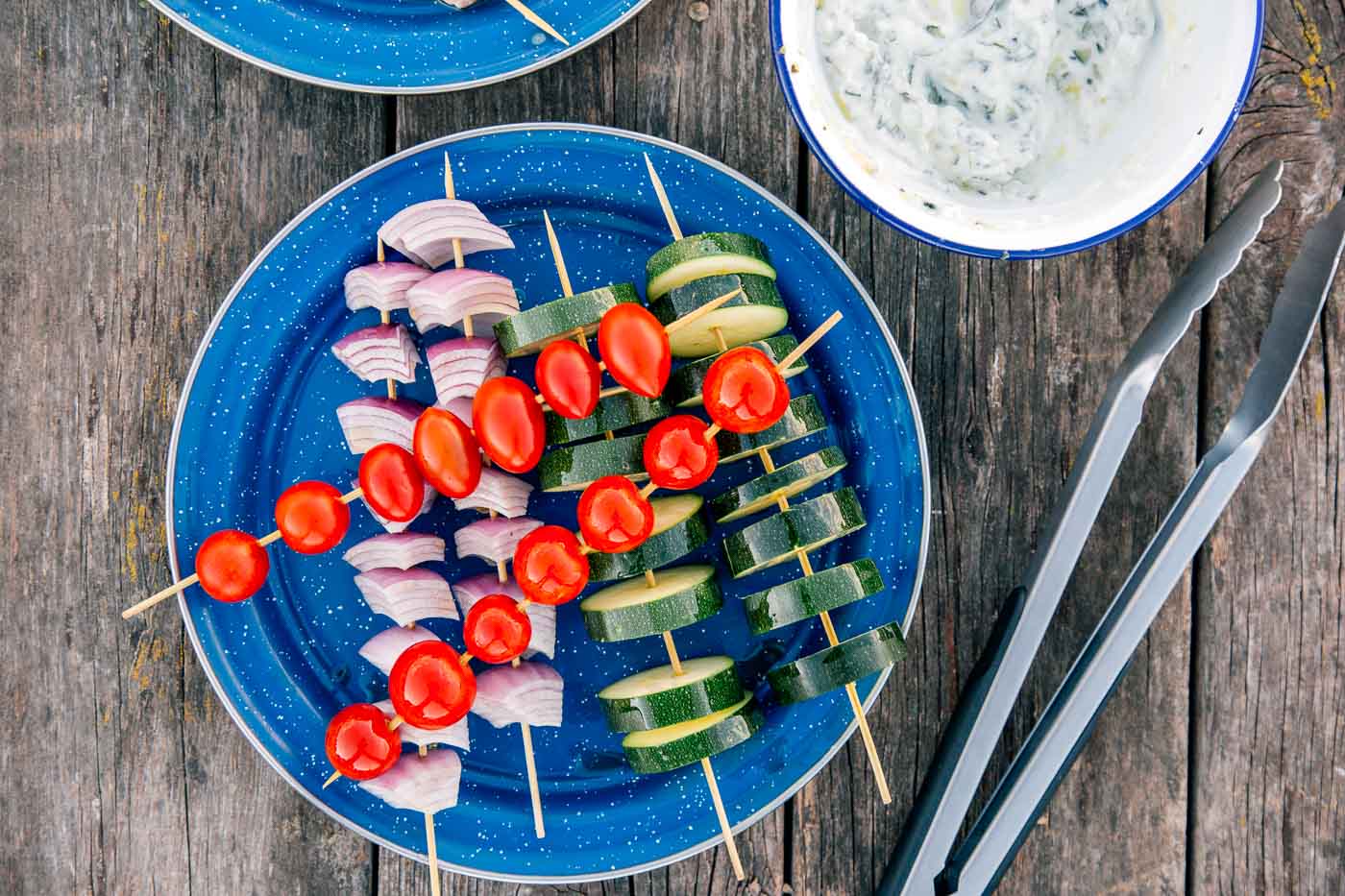
Vegetables
You’ll want to bring plenty of vegetables on every camping trip — and we’re here to assure you that packing fresh vegetables is totally easy enough to to! Many whole veggies do not need to be kept in a cooler, so you don’t need to worry about them taking up space. However, chopping and dicing vegetables at home can be a huge time saver when you’re cooking in camp.
If you prep your veggies ahead of time, you’ll want to store them in water-tight containers in the cooler. You don’t need them to stay super cold, so these often get stored towards the top of our cooler, leaving things like meat to be stored closer to the bottom where it’s much colder.
Here are a bunch of great vegetables that transport well on a camping trip:
- Corn
- Cherry tomatoes (transfer to a hard sided container)
- Cucumbers
- Bell peppers
- Potatoes or sweet potatoes
- Zucchini or summer squash
- Cabbage (red or green)
- Carrots
- Avocados
- Onions & garlic
- Fresh herbs—these require some extra TLC but it’s SO worth it to have fresh herbs on hand to add to meals (especially herbs like basil, mint, and cilantro!). At home, cut off the ends of the herbs and stand them in a mason jar. Add about ½ inch of water to the bottom, then seal the jar. They should stay perky and fresh in your cooler for a few days this way–just be sure the jar stays upright.
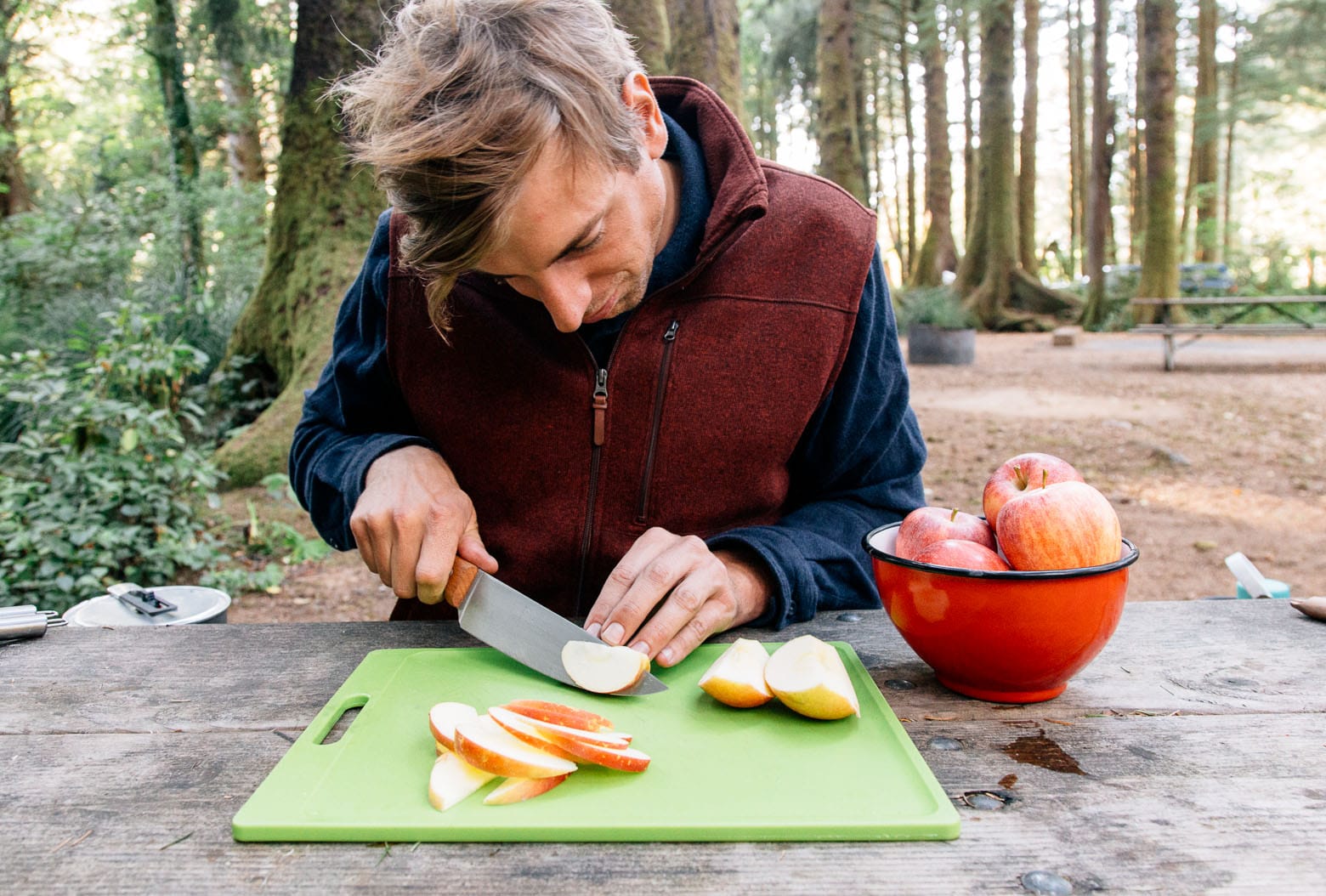
Fresh Fruit
We like to bring an assortment of fruit on our camping trips. Like vegetables, uncut fresh fruit doesn’t typically need to be stored in the cooler (though cold grapes are a great snack!). Fruit can be enjoyed on its own, or sliced and added to breakfasts like oatmeal or yogurt, used as a pancake topping, or for a number of desserts.
Soft fruits (peaches, plums, mango) can be sliced or chopped ahead of time and stored in a hard sided container in the cooler so you don’t need to worry about them bruising. We love fresh mango in salsas (try these shrimp tacos with mango salsa), and of course, Dutch Oven Peach Cobbler is a summertime classic!
Here are a few of our favorite fruits to bring when we’re going camping:
- Apples
- Pears
- Grapes
- Oranges or clementines
- Lemons
- Limes
- Melons (cut up at home and store in a hard sided container in the cooler)
- Berries (transfer to a hard sided container)
- Bananas (use them early before they get too ripe and strong smelling. We love them for Banana Boats or in these Banana Bread Pancakes!)
- Mango (slice at home and store in a hard sided container in the cooler to prevent bruising)
- Peaches & other stone fruit (slice at home and store in a hard sided container in the cooler to prevent bruising)
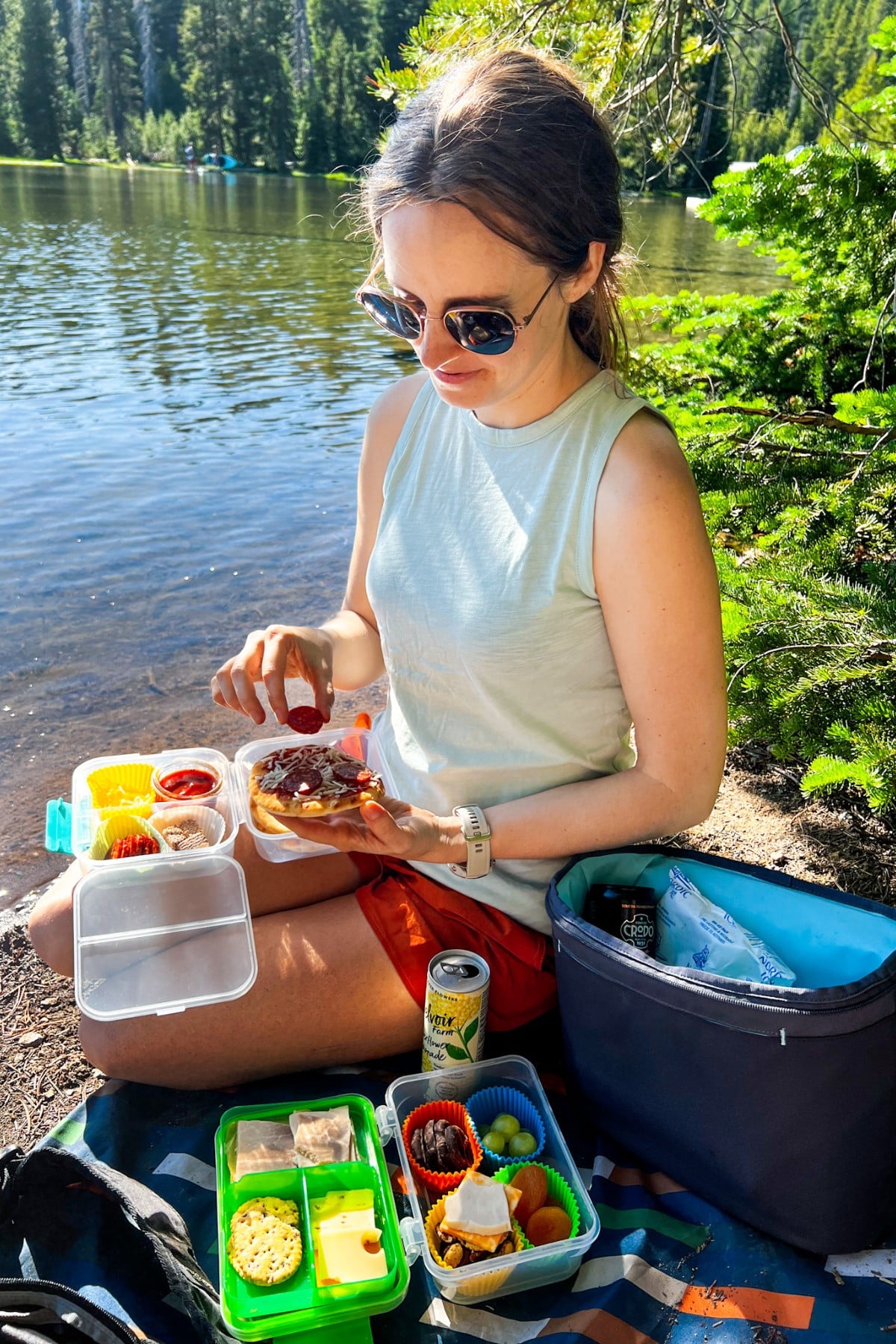
Snacks
We’re not going to lie–about half the food we pack for car camping are snacks! We like to be able to graze throughout the day, and have lots of variety to bring with us if we’re going to spend the day hiking or hanging out by the lake. Here are some great camping snack ideas that pack and transport well:
- Trail mix
- Chips with dip or salsa
- Peanut butter filled pretzels
- Sliced fruit or vegetables
- Granola bars
- Hummus
- Popcorn
- Olives
- Nuts
- Salami
- Babybel cheese/cheese sticks
- Dried fruit
- See all of our favorite hiking snacks–these are great to have on hand to throw into your backpack
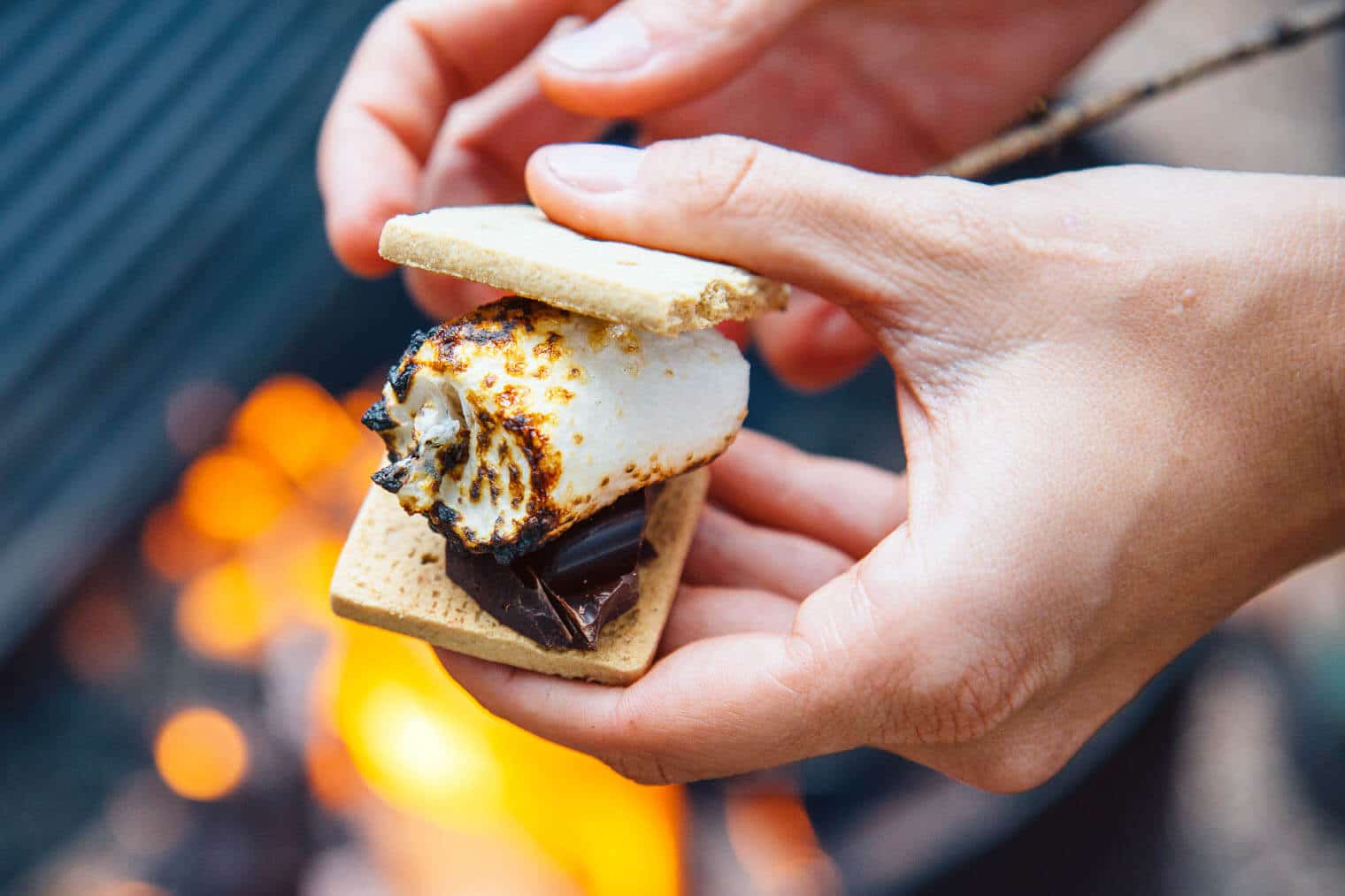
Graham Crackers, Marshmallows & Chocolate
What’s a camping trip without s’mores?! If you plan on having a campfire, be sure to bring your favorite s’mores ingredients, whether it’s just the classics or something a little more creative! (We love to add raspberries to ours!)
If you can’t have a campfire, make these s’mores cookies at home and bring them along to capture the spirit of the classic camping dessert.
Sauces/Marinades
Sauces and marinades, whether homemade or store-bought, are an easy way to add a ton of flavor to meals without having to bring along a ton of ingredients. Think pasta sauce, BBQ sauce, fajita simmer sauce, jarred curry sauce, pad thai sauce, or herb-based sauces like pesto, chimichurri, and chermoula.
Condiments
Once you have an idea of what meals you’ll be cooking at your campsite, think about the condiments you might need:
- Hot sauce
- Ketchup
- Mayo
- Mustard
- Relish
- Sauerkraut
- Pickles
- BBQ sauce
- Sour cream
- Salsa
- Salad dressing
- Ranch
If you know you only need a little bit of something, skip bringing the whole bottle and repackage in to refillable squeeze tubes like these GoToobs (we’ve never had these leak) or these twist-top condiment bottles.
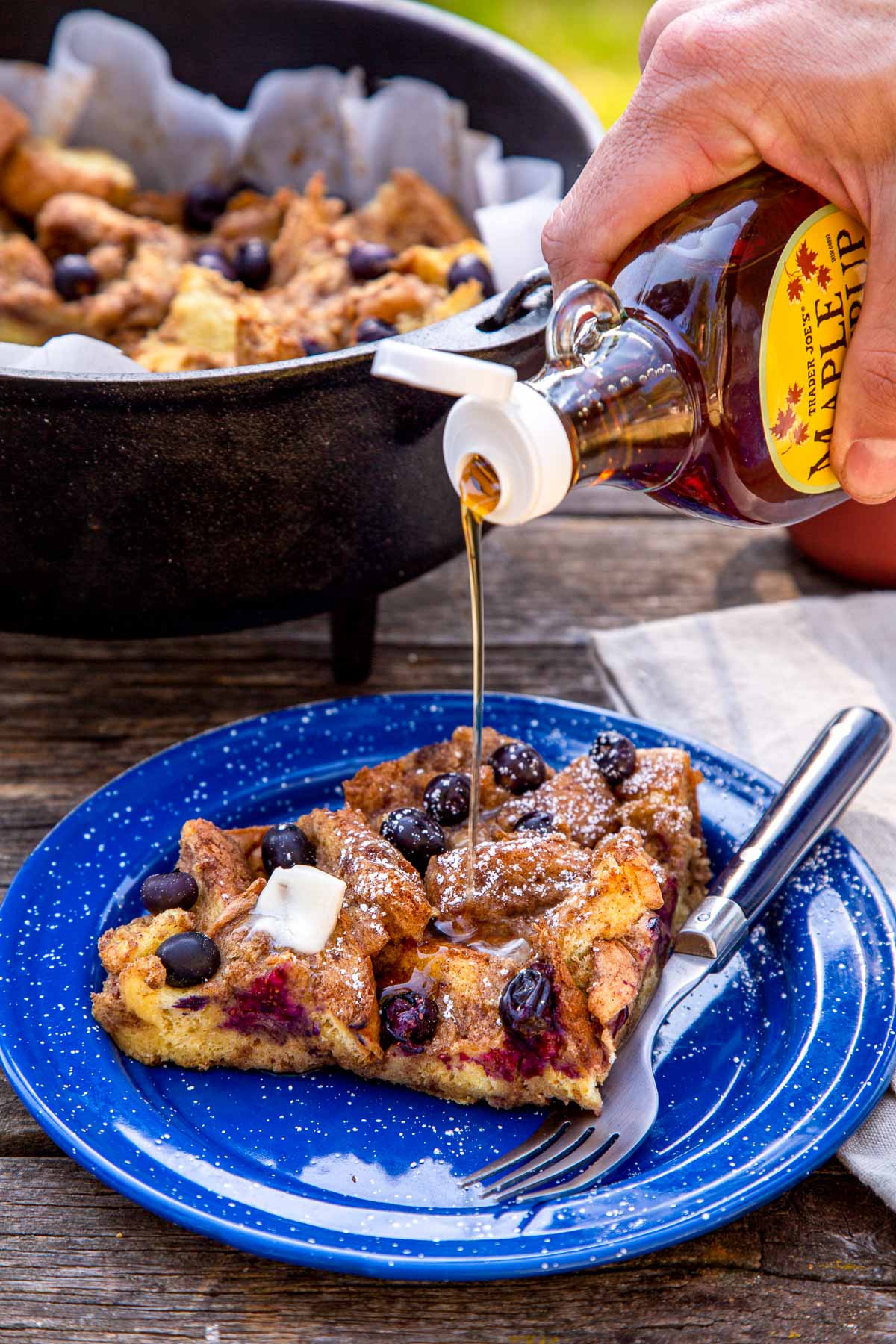
Sweeteners
Be sure to bring your favorite sweetener for topping pancakes, stirring into hot drinks, sweetening oatmeal, etc.
- Maple syrup
- Honey
- Agave syrup
- Sugar (make sure you have enough if you’re making pancakes or desserts on-site)
Spices & Seasonings
Spice blends are a simple way to add flavor and transform a simple meal without bringing your whole spice cabinet. We also like to bring a few of our go-to spices depending on what is on the menu.
- Salt & pepper
- Garlic powder
- Onion powder
- Taco seasoning
- Adobo
- Garam masala
- Blackening seasoning
- BBQ dry rub
- Cajun seasoning
- Jerk spice
- Ras el hanout
Butter & Oil
Be sure to bring butter and/or your favorite oil for cooking! We like to have butter on hand for slathering on English muffins, pancakes, and grilled bread. We prefer ghee or coconut oil for frying pancakes, rather than butter, because it has a higher smoke point. For cooking and sauteing, choose a neutral flavored oil.
- Storage tips: Store butter either in the top basket of your cooler (if it has one), or in a hard-sided container or leak-proof bag–you don’t want it to float around unprotected in your ice water! Make sure any containers of oil have a good, twist on cap that won’t pop off.
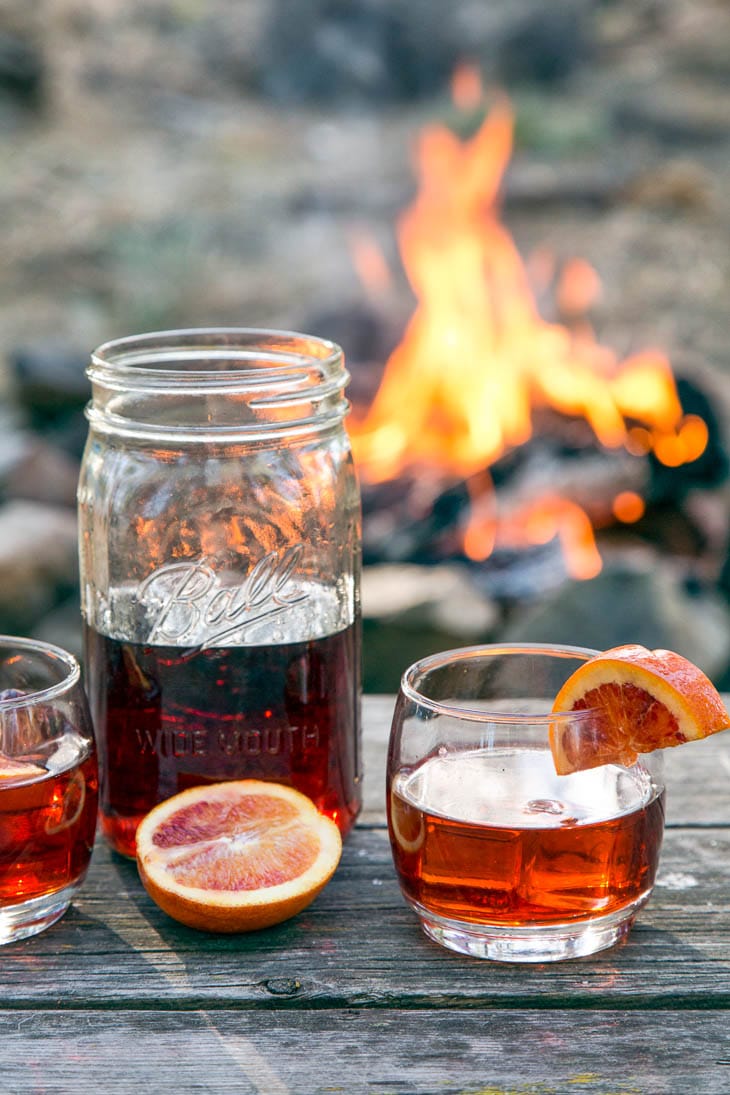
Drinks
In addition to packing your favorite drinks, double check that your campsite has clean, potable water available–if not, you’ll need to pack sufficient amounts of your own to last the trip.
- Coffee & tea
- Juice
- Hot cocoa mix
- Sparkling water or seltzer
- Beer/wine/cocktails
Camp Hack: If you have a favorite camp cocktail, mix a big batch at home and leave all the bottles at home! We’re a fan of camping Negronis, but this method will work for many other cocktails as well.
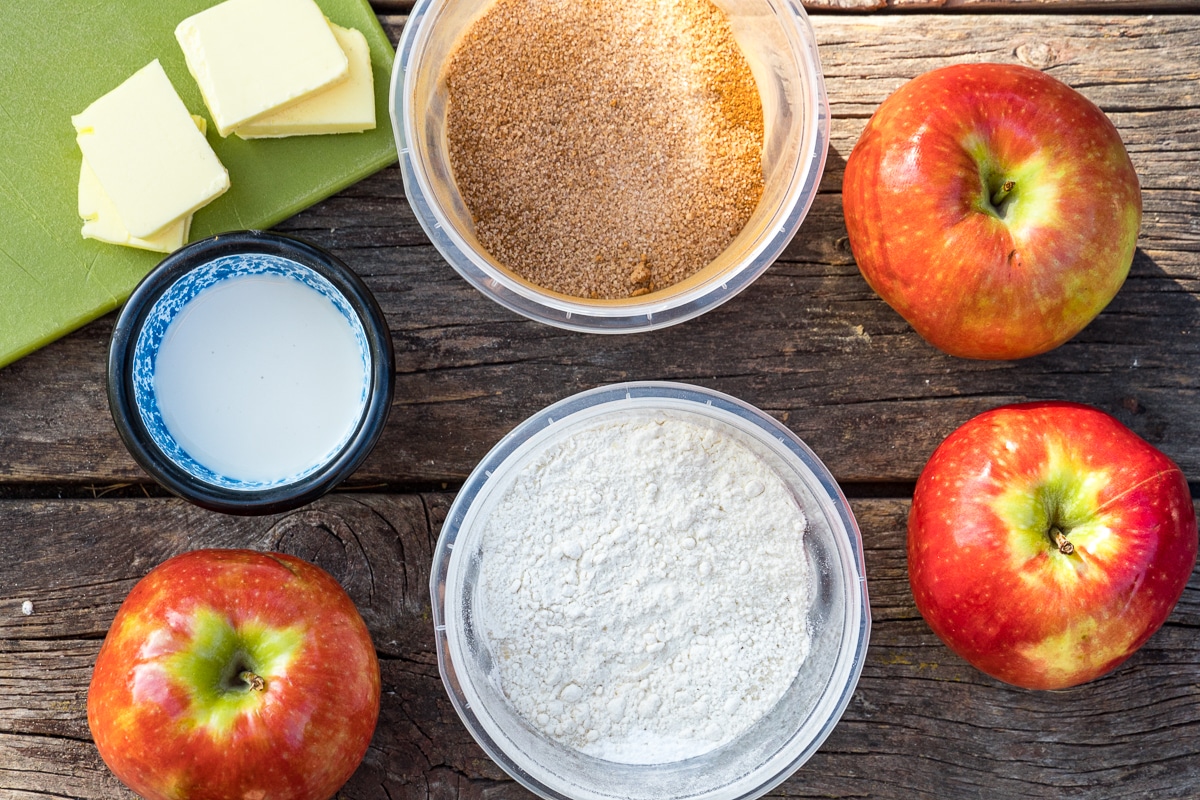
Camping Meal Prep Tips
Prep what you can at home: You might only have time to pre-chop some veggies, or you may be able to make a complete meal. Either way, any work you can do now means less work (and clean up!) you’ll have to do at the campsite.
Start marinades at home: At a minimum, you should start your marinades at home! Add all the marinade ingredients EXCEPT any acids (vinegar, lemon juice, etc) to a zip top bag and add the meat (or whatever you’re marinating). Store in your cooler. At the campsite, add any vinegar or citrus juice needed–adding it later will prevent the meat from getting mushy or tough.
Reduce packaging / pack what you need: No need to bring the whole bag of sugar! Repackage bulk ingredients so you’re only bringing what you need. This goes for things like flour, sauces and condiments, bulk spices, etc.
Have a backup meal: We always carry an easy backup meal that we can turn to if we end up hanging out at the lake for too long, or come back to the campsite too tired (or lazy!) to cook our planned meal. Throw a box of mac and cheese or a can of soup into your pantry box and you’re set.
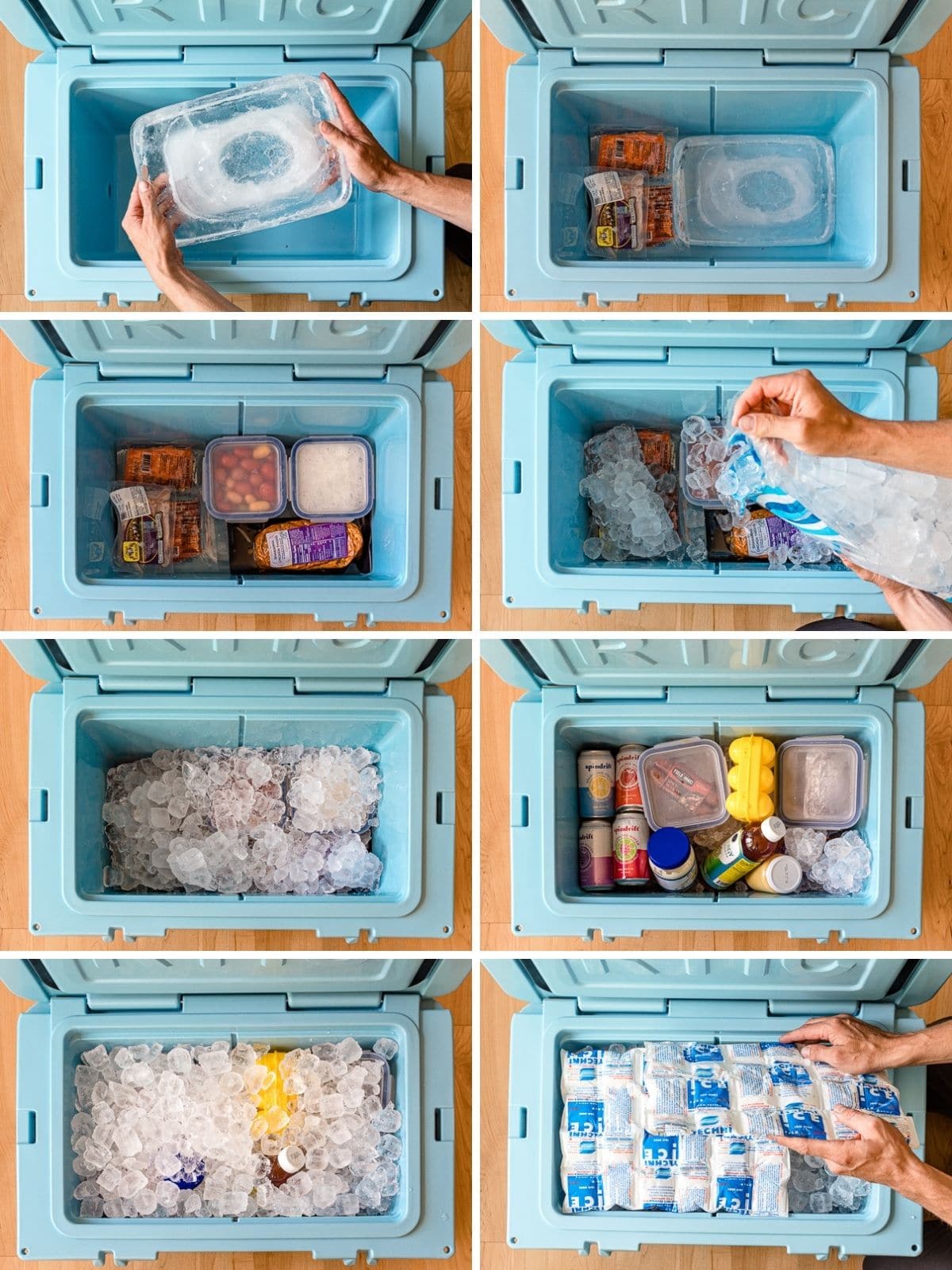
A Crash Course to Packing Your Cooler
Prep your cooler: Bring it inside a day before you need to pack it (especially if it’s been stored somewhere warm) and give it a good rinse. Pre-chilling your cooler by filling it with cold water or “sacrificial” ice can also help it stay colder later on.
Prep your food: As mentioned in the section above, you’ll want to repackage anything bulky or that’s not watertight before storing it in the cooler. The less air in your packaging, the better! Then, freeze anything that will be used towards the end of the trip (assuming it freezes well–meat is the best candidate) and refrigerate everything else. You want the food to start out as cold as possible.
Add ice & pack the cooler: To ensure your cooler stays at a food-safe temperature (41F) for as long as possible, you’ll want to aim for a 2:1 ice to food ratio. Yes, that means twice the amount of ice as food or drinks. Good news–anything you freeze counts as part of the “ice”!
Add ice and frozen food to the bottom of the cooler, then layer in the rest of your food between layers of ice. Place things like meat towards the bottom and items like chopped fruit, veggies, and herbs at the top.
There’s lots more to know about keeping your cooler as cold as possible for longer, including tips on how to manage it at camp, in our guide to how to pack a cooler, so be sure to read the full post!
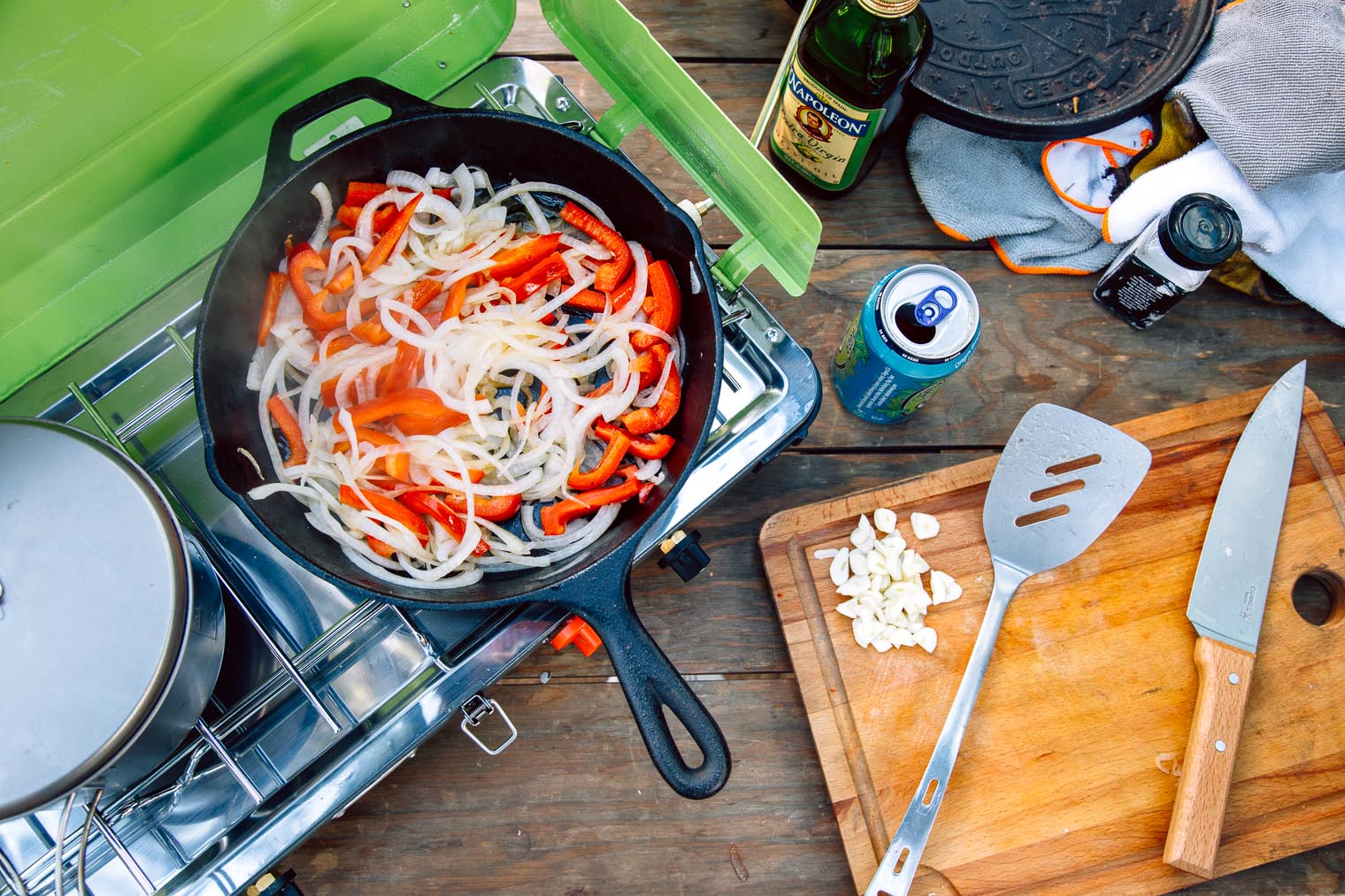
Basic Camp Cooking Gear
Once you have your camping meals planned out, spend a few minutes thinking about what camp kitchen tools you’ll need to cook them. Here’s a quick list of some of the most common cooking gear:
- Stove (find the best camping stoves here)
- Cooler (our top pick)
- Non-stick pans (we love these)
- Cast iron skillet
- Pot
- Knife (with a protective cover)
- Cutting board
- Spatula
- Large mixing spoon
- Tongs
- Pot holders
- Instant read thermometer (our favorite)
- Dutch oven (optional)
- Foil (optional)
- Can opener
- Bottle opener/corkscrew
- Coffee maker (learn about the different ways to make camping coffee here!)
You can also refer to our camp cooking gear or camping checklist posts here for more ideas!

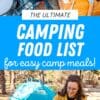
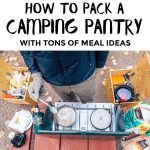
Love. Love. Love this post! It’s super helpful in helping us plan what we ACTUALLY should be stocking in our hatchback’s pantry. I’m a big planner and would definitely try to stock more than we would actually need. And ghee!!!! That’s a brilliant idea…as a Southerner (hailing from deep South GA), butter is my go-to for so many things that I cook. I was already having separation anxiety thinking that we’d not be cooking with butter very often. Haha. Couple of questions… Do you typically purchase pantry staples online, specifically the coconut milk powder and the shelf-stable tofu? I know y’all are big Trader Joe’s fans; are you able to find these items in stores or are you forced to purchase online?
Thanks! Glad you found it to be helpful! Ghee can be found at Whole Foods & Trader Joe’s. Coconut Milk powder can be tricky to find. We used to get it from a Indian market when we lived in LA (there were a few Asian grocers that carried it as well), but haven’t seen it many places since – so that’s one we’d pick up online. Shelf Stable Tofu we’ve seen in a few grocery stores (Whole Foods and some major chains in bigger cities) but it’s not everywhere. Since we’re a moving target, we typically try to avoid ordering online (shipping can be difficult to coordinate) and instead stock up when we’re in a town with a well stocked store. Some things are more expensive online than in store (especially basic pantry items – i.e. canned beans). But for the more speciality items, it might be worth ordering online rather than running all around town trying to find something specific.
Awesome post. I’ll be adding some of these to my camping list. If you haven’t already check out flavor God spices. They are amazing. Spicy blend is my favorite!!!!!
Oo, thanks for the tip! We’re always looking for new spice blends – that is seriously the easiest way to switch up simple meals!
Great post! Did you guys make that cool foldout table and the crates? If so, would you mind sharing the basic measurements and assembly? Also, what basic cookware do you carry in the pantry?
Hello,
Your story has inspired me to move out!
I’m actually about to purcahse a focus today. Which size cargo box do you guys use?
Would you reccomend larger or smaller?
Thanks!
-Chris
Just found your site. Love it. Have been a Dutch oven camp cook for many, many years. (Think fresh yeast cinnamon rolls in camp.) I just added a new item to my camp box–“the ringer, stainless steel cast iron cleaner.” It works great. Have one for each home and camp. Check it out.
Thanks! Is this the one? http://amzn.to/2n2XfCj Definitely looks like something we should add to our kit as well. Thank you so much for sharing!
That is it.
Great post and super informative! About to hit the road for a week of camping and I love your recipes – healthy and veg friendly. Keep up the good work.
Cheers – CT
Love this post! My boyfriend and I are preparing for an extended cross-country road trip and we’re both huge foodies. This post and your blog has been perfect in helping me put together a packing list and inventory for us! Thank you for all of your insight and inspiration.
That’s awesome! Have a great time on your road trip. Hope this list helps!
That’s a huge list of foods and snacks and while seeing this post water began to jump on my tongue. Lol
Did you make or purchase your wooden boxes? If you made them where did you find the plans? If you purchased them, who sells them?
Our good friend who is a former carpenter built the boxes for us. They were custom designed to fit in the passenger footwell of our hatchback so unfortunately, they weren’t built off of any plans that we can direct you to 🙁
Easy pezzy boxes, i use the large milk crates, work great for can goods. Garage sales you can find good camping items and second hand good will store. For pots and pans ect cheap a buck or two.
We’re gearing up for a cross country mission and due to COVID, trying to be as self sustaining as possible. This is an awesome resource, thank you for putting it together!!!
I have raised my 4 boys camping. My husband was an Eagle Scout. I was a cook etc. so you know what that entailed. I have to say I love your lists for all things camping. Great for people to get out in nature if they thought too daunting. Organization is my hobby so love the ideas. Its been awhile and we have invited all 4 w/ families on a one week trip. One of the bucket list adventures on our 50th year married. It is good to see pictures of yourselves camping with the items around you so people can see a visual. I know it jogged my memory.